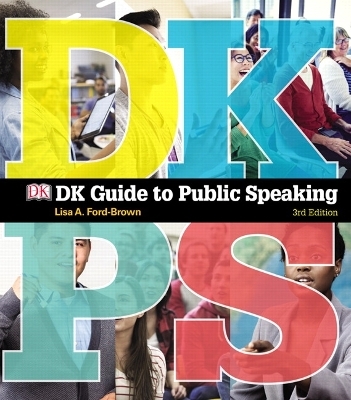
DK Guide to Public Speaking
Pearson (Verlag)
978-0-13-438089-6 (ISBN)
- Titel z.Zt. nicht lieferbar
- Versandkostenfrei
- Auch auf Rechnung
- Artikel merken
An easy-to-navigate, visually engaging guide to becoming an effective public speaker
DK Guide to Public Speaking gives students the practical information they seek, supported by the concepts and theories instructors want — all presented within a compelling Dorling Kindersley design that facilitates an intuitive learning experience. Author Lisa Ford-Brown offers a user-friendly resource that equips students with the tools to become effective public speakers. The Third Edition has been updated with contemporary examples of speeches and presentation aids to engage students and ensure a contemporary view of public speaking.
DK Guide to Public Speaking, Third Edition is also available via Revel™, an interactive learning environment that enables students to read, practice, and study in one continuous experience.
About our authors Lisa A. Ford-Brown is a writer and educator dedicated to the field of human communication. Her books include the DK Guide to Public Speaking, the DK Speaker and DK Communication. She earned her B.S. and M.A. from Indiana State University in Speech Communication with minors in English, the Visual Arts and Women’s Studies. She holds a PhD in Speech Communication from Southern Illinois University, Carbondale. She currently teaches at Columbia College. From 2003 to 2005, Dr. Ford-Brown chaired the Columbia College Humanities Department and served as a member of their Board of Trustees from 2008 to 2010. Prior to her current position, she taught at Indiana State University and the University of Dubuque. She has received several performance and teaching awards. Most notably, she was named advisor of the year at Columbia College and Faculty of the year at Columbia College and the University of Dubuque. She is a long-standing member of the National Communication Association, Central States Speech Association and the National Honor Society of Phi Kappa Phi. Dr. Ford-Brown and her partner, Bruce, live on a small 20-acre farm with their 2 golden retrievers (Zelda and Pucc) and 2 cats (Sadie and Falstaff). They enjoy traveling, camping, fishing, gardening, woodworking, pottery making and watching the grass grow.
I. Brief Table of Contents
TAB 1: STARTING
1. Overview of Public Speaking
2. Getting to Know Your Audience and Situation
3. Selecting Your Topic and Purpose
TAB 2: RESEARCHING
4. Locating Support Materials
5. Selecting and Testing Support Materials
TAB 3: CREATING
6. Outlining Your Speech
7. Organizing the Speech Body
8. Introducing and Concluding Your Speech
TAB 4: PRESENTING
9. Using Language Successfully
10. Delivering Your Speech
11. Using Presentation Aids
TAB 5: LISTENING AND EVALUATING
12. Listening
13. Evaluating Speeches
TAB 6: SPEAKING TO INFORM
14. The Informative Speech
TAB 7: SPEAKING TO PERSUADE
15. Tools for Persuading
16. The Persuasive Speech
TAB 8: SPEAKING ON SPECIAL OCCASIONS
17. Speeches for Special Events
TAB 9: SPEAKING IN PROFESSIONAL AND GROUP SETTINGS
18. On-the-Job Speaking
19. Speaking in Small Groups
Appendix: Mediated Public Speaking
II. Detailed Table of Contents
TAB 1: STARTING
1. Overview of Public Speaking
1.1 Using the skills
1.2 The process of communicating
1.3 Be a successful public speaker
1.4 Overcome a fear of public speaking
1.5 Be an ethical public speaker
1.6 The creative process for public speaking
Chapter 1 Review
2. Getting to Know Your Audience and Situation
2.1 Why you need to know your audience and situation
2.2 What you need to know about your audience
2.3 Traits to investigate
2.4 What you need to know about the situation
2.5 Analyze the audience and situation
2.6 Adapt to your audience and situation
Chapter 2 Review
3. Selecting Your Topic and Purpose
3.1 Select a topic
3.2 Narrow your topic
3.3 Create a central idea
3.4 Construct a working outline
Chapter 3 Review
Practical Pointers for Tab 1
TAB 2: RESEARCHING
4. Locating Support Materials
4.1 Locating support materials
4.2 The Internet
4.3 The library
4.4 On the Internet and in libraries
4.5 Interviews
4.6 Surveys
4.7 Researching effectively
Chapter 4 Review
5. Selecting and Testing Support Materials
5.1 Types of support materials
5.2 Determine types of sources to use
5.3 Evaluate support materials
5.4 Use materials effectively
5.5 Cite sources orally
Chapter 5 Review
Practical Pointers for Tab 2
TAB 3: CREATING
6. Outlining Your Speech
6.1 Parts of an outline
6.2 Create an effective outline
6.3 Types of outlines
6.4 Link your speech parts
6.5 Cite sources in your outline
6.6 Create a source page
Chapter 6 Review
7. Organizing the Speech Body
7.1 Organizational strategies
7.2 Make a speech out of a strategy
Chapter 7 Review
8. Introducing and Concluding Your Speech
8.1 What an introduction should do
8.2 Attention-getters
8.3 Organizing an introduction
8.4 What a conclusion should do
8.5 “WOW” statements
8.6 Organizing a conclusion
Chapter 8 Review
Practical Pointers for Tab 3
TAB 4: PRESENTING
9. Using Language Successfully
9.1 What makes language important
9.2 Using language effectively
9.3 Boosting your distinctiveness
Chapter 9 Review
10. Delivering Your Speech
10.1 Elements of vocal delivery
10.2 Elements of physical delivery
10.3 Methods of delivery
10.4 Preparing for an extemporaneous speech
10.5 Mediated presentations
Chapter 10 Review
11. Using Presentation Aids
11.1 Types of presentation aids
11.2 Determine what aids you need
11.3 Methods for displaying aids
11.4 Crafting an effective aid
11.5 Using presentation software
11.6 Using aids successfully
Chapter 11 Review
Practical Pointers for Tab 4
TAB 5: LISTENING AND EVALUATING
12. Listening
12.1 Why listening is important
12.2 The process of listening
12.3 Types of listening
12.4 What can prevent listening
12.5 Helping your audience listen
12.6 How you can listen more effectively
Chapter 12 Review
13. Evaluating Speeches
13.1 Why evaluation is important
13.2 Evaluating speeches
13.3 Who evaluates your speech
Chapter 13 Review
Practical Pointers for Tab 5
TAB 6: SPEAKING TO INFORM
14. The Informative Speech
14.1 Informative speaking
14.2 The creative process for informative speaking
14.3 Choose an informative topic
14.4 Research the informative speech
14.5 Outline and organize an informative speech
14.6 Prepare to present your speech
14.7 Evaluate an informative speech
Chapter 14 Review
Practical Pointers for Tab 6
TAB 7: SPEAKING TO PERSUADE
15. Tools for Persuading
15.1 Persuasive speaking
15.2 What a persuasive speech should do
15.3 Traditional appeals
15.4 Modern appeals
15.5 Parts of an argument
15.6 Types of arguments
Chapter 15 Review
16. The Persuasive Speech
16.1 The creative process for persuasive speaking
16.2 Choose a persuasive topic
16.3 Research the persuasive speech
16.4 Outline and organize a persuasive speech
16.5 Prepare to present your speech
16.6 Evaluate a persuasive speech
Chapter 16 Review
Practical Pointers for Tab 7
TAB 8: SPEAKING ON SPECIAL OCCASIONS
17. Speeches for Special Events
17.1 Special occasion speech purposes
17.2 The creative process for special occasion speaking
17.3 Writing a special occasion speech
17.4 Types of special occasion speeches
Chapter 17 Review
Practical Pointers for Tab 8
TAB 9: SPEAKING IN PROFESSIONAL AND GROUP SETTINGS
18. On-the-Job Speaking
18.1 Communicating in an interview
18.2 Creating a business presentation
18.3 Communicating in a meeting
18.4 Communicating in a review
Chapter 18 Review
19. Speaking in Small Groups
19.1 What makes a small group
19.2 Roles in a small group
19.3 How groups make decisions or solve problems
19.4 How groups present findings
Chapter 19 Review
Practical Pointers for Tab 9
Appendix: Mediated Public Speaking
Introduction: Mediated Public Speaking
A.1 Mediated Communication: An Introduction
A.2 Types of Online Presentations
A.3 Advantages and Disadvantages of Online Presentations
A.4 Audience
A.5 Preparing for Your Online Presentation
A.6 Practicing Your Online Presentation
A.7 Delivering or Recording Your Online Presentation
A.8 Online Etiquette: Digital Citizenship
Appendix Review
| Erscheinungsdatum | 18.02.2017 |
|---|---|
| Sprache | englisch |
| Maße | 175 x 200 mm |
| Gewicht | 570 g |
| Themenwelt | Kunst / Musik / Theater ► Theater / Ballett |
| Sachbuch/Ratgeber ► Beruf / Finanzen / Recht / Wirtschaft ► Briefe / Präsentation / Rhetorik | |
| Schulbuch / Wörterbuch | |
| Sozialwissenschaften ► Pädagogik | |
| ISBN-10 | 0-13-438089-4 / 0134380894 |
| ISBN-13 | 978-0-13-438089-6 / 9780134380896 |
| Zustand | Neuware |
| Haben Sie eine Frage zum Produkt? |
aus dem Bereich


